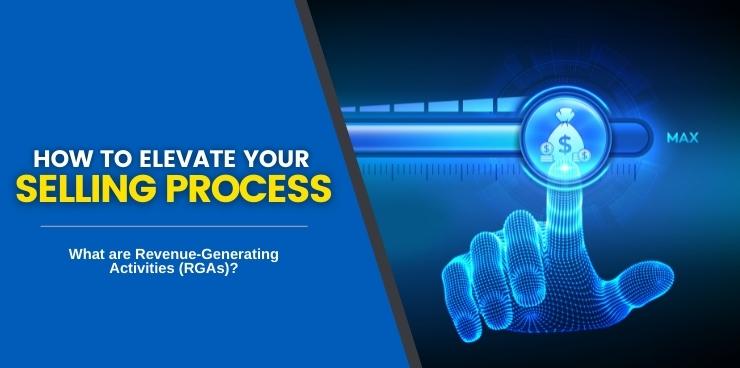If no one’s told you before, you’re the only one who can achieve your revenue goals, and revenue-generating activities are the key to your success. The devil is in the busy work that keeps you distracted.
The more time you waste on the hustle and bustle, paper shuffle – on tasks that aren’t producing income – the more behind you get. Contractors spend much of their time on marketing, accounting, scheduling, and managing their overall operations. All selling operations have one CORE Mission – to close more customers.
The most vital tasks for any business are the ones that generate revenue. This means spending time on the right things, like generating revenue. Did I mention generating revenue? It’s all about revenue.
“Your business will accelerate profitable growth when Sales stop being
a distraction and inconvenience to Operations.”
-Ryan Chute
As a business owner, it’s your job to build a system and processes to deliver the bigger picture. What daily tasks on your team’s to-do list actually contribute to the bottom line? Can you delegate non-revenue-generating activities to people not responsible for selling? Your bottom line relies on it.
Think of revenue-generating activities for businesses as the means to end – an end that closes the deal. Some revenue strategy examples for a residential home service company include, but are not limited to:
- Booking appointments.
- Diagnosing issues and selling services.
- Selling maintenance memberships.
- Selling new units.
- Upselling, cross-selling, and bundling solutions with finance options.
- Closing deals.
- Following up on unsold business.
For each revenue-generating activity, there are several things you can do to increase sales and, in turn, your bottom line. By generating revenue, your business ensures its long-term sustainability.
So if the shoe fits, wear it. But make the wrong step, and your business might implode. Managing non-revenue generating activity strategically will allow you to reach your revenue goals.
What are Revenue-Generating Activities (RGA’s)?
Revenue is the lifeblood of every business, and without money, your business simply would not exist. Revenue-generating activities (RGAs) are those activities that are working toward a revenue outcome for your business.
There are many ways to generate revenue, but some common methods a home services business include:
- Selling products or services.
- Renting out equipment and tools.
- Subcontracting your services.
- Subscription services.
- Affiliate commissions for subcontractors.
While all businesses need to generate revenue, not all revenue is created equal. Some revenue streams are more stable and predictable than others, and some revenue generates a higher profit than others.
It’s crucial to note the difference between a task that leads to a sale and the actual sale itself. The former is all about income generation. The latter is the actual exchange of money for goods or services.
Revenue-generating activities include advertising, prospecting, setting appointments, selling, and closing. They’re vital to any business but don’t necessarily result in an immediate sale. Rather, they create the conditions under which a sale can happen.
The actual sale is the moment of exchange. It’s where all the hard work of advertising and sales pays off. The culmination of all those income-generating activities is what keeps a business afloat.
Without sales, there would be no income. And without income, a business cannot survive.
Develop a revenue-generating strategy for your business with the home service selling experts. Book a demo with Wizard of Sales® today!
Non-Revenue Generating Activity Examples
Non-revenue-generating activities keep your people busy with work that doesn’t help pay the bills. Non-revenue-generating activities are busy work.
Busy work includes anything that does not fall into the generating revenue category. It might include things like:
- Paperwork: Shuffling papers around in a bid to look busy or important. Some paperwork is necessary. How much could be handed off to an administrative assistant to ensure thoroughness and accuracy, and how much is necessary for the revenue-generator to do?
- Personal endeavors: Calling family or friends, surfing Facebook, or making grocery lists. In a study tracking what people do in 30-minute increments, it was found that over 50% of the time was wasted on personal efforts.
- Windshield time: Getting to and fro doesn’t make you money. Are there ways to decrease drive time and distance between calls?
- Potty time: Grown adults can be responsible about when and how long they use the amenities.
- Customer service: Waiting idly for calls to come in is bad enough. These folks could be outbound calling or doing follow-up calls on unsold business and club members. Handling callbacks and warranty work is all busy work that could have been avoided (at least partially) by delivering higher quality at upfront.
- Deleting emails: Managing your emails can be a full-time job if you’re not careful. How many emails could be eliminated? How much time should revenue-generating employees be bogged down with emailing, when they could be either in front of the customers or on the phone?
- Training time: Training time is essential to the success of any residential home service company. The question is, how effective is the training you deliver and how much is lost when trying to lump too much content into one session?
- Socializing: The ol’ water cooler can suck the efficiency out of any office if left unattended. You get what you tolerate.
- Administrative work: Benefits discussions, limited or non-existent processes, discipline, schedule changes, and all the other little things that add up to a lot of lost time.
- Sending quotes: Stop sending quotes! If you aren’t closing on the first sit, you should be chasing up the next appointment. Ain’t nobody got time to send out quotes all the time.
- Putting out fires: Solving problems that should have been solved before they became a problem. Better communication and handling things immediately are the quick solution to eliminating wasted time and endless distractions.
- Performance reviews: Dewey Jenkins of Morris-Jenkins always said, “there are better ways to upset an employee than Performance Reviews”. If you aren’t dealing with issues in the moment and having regular one-on-one conversations, you’re doing it wrong.
- Meetings: 90% of meetings could have been an email. When you stop having boring and pointless meetings, you free up time for the good stuff. Save meetings for training, celebrations, and making decisions.
These are all examples of time-wasting activities that salespeople endlessly engage in. If you find your team doing any of these things regularly, it’s time to re-evaluate priorities and find ways to cut time wasting activities. At the very least, look at how you can defer or reallocate your resources so that your revenue-generators are performing revenue-generating activities for at least 80% of their day.
One way to do this is to set specific times for each task unrelated to revenue, and then stick to those schedules as closely as possible. Alternatively, it is essential that you set aside enough time to get the necessary revenue-generating activities completed to meet or exceed your revenue goals. For instance, you know you need to book 10 outbound calls per day. Block out two hours in the schedule specifically for making those calls, and then make sure you don’t let anything else interfere with that time.
Another way to cut down on wasted time is to streamline your processes and eliminate anything that isn’t helping you achieve your revenue goals. For instance, let’s say you salespeople have to email quotes and it takes them 3 hours each day building quotes and sending emails. Instead, work on closing techniques that have them rebooking unsold leads to a specific appointment time to review further details with all decision makers or simply closing them on the first sit.
Finally, make sure to use your time wisely by taking regular breaks. Schedule buffer time into the day, and make time for activities that relax and rejuvenate people. It will help everyone stay focused and productive and prevent burnout in the long run.
The goal of any business is to make money, and busy work does not generate revenue. Some are necessary, but most are not. Anything that is not revenue-generating, get it into a non-selling role and leave your sellers to do what they do best.
Non-revenue-generating activities have a major impact on your bottom line. If this is how your sales team spends half their shift, you’re definitely leaving money on the table. If this is the case, it’s time to make a change.
Inspect what you expect.
Your managers and employees are a reflection of your leadership. The Turks say, “a fish rots from the head down”. Evaluate the current state of your business. Your success depends on it.
How Do You Make It Easier for Your Sellers to Sell & Buyers to Buy?
Take a moment to reflect on your current revenue generation process. Is there a specific way you ask your salespeople to show up every day, on every call? Do they know how to navigate skepticism from your prospects and close the sale?
Time management is critical for salespeople because they often have many demands on their time unrelated to revenue generation. They have to juggle customer calls, meetings, and maybe even prospecting, while also trying to find time to do administrative tasks like updating their CRM or preparing quotes.
Salespeople must prioritize their time to focus on activities that generate revenue. A salesperson who spends too much time on administrative tasks will not have enough time to close appointments and deals with potential customers.
Creating a Selling System
The key to income generation is making it easier for your sellers to sell and buyers to buy. How exactly could you do that as a business owner?
A Selling System™ will help you increase your revenue effectively following three simple rules.
 1. Overcome bottlenecks in your strategy
1. Overcome bottlenecks in your strategy
One of the biggest bottlenecks in selling strategy can be lacking focus. It’s easy to get caught up in the day-to-day details and lose sight of your overarching revenue goals. That’s why it’s crucial to have a clear plan and stay focused on your targets.
Another common bottleneck is an inefficient sales process. Not constantly evaluating and improving your process will hold you back. That includes spending (and wasting) time on non-revenue-generating activities.
You can overcome this by streamlining your sales process. Identify and eliminate unnecessary steps that are slowing down your sales cycle. Streamlining allows you to focus on RGAs and close deals more efficiently.
Automating non-priority tasks where possible is another effective strategy. Using customer relationship management (CRM) software automates follow-ups or confirms appointments. And marketing automation tools can generate leads and track their progress through the sales funnel.
2. Eliminate blind spots in your communication
Sales teams are often siloed, with members working in isolation from one another. That leads to communication blind spots, where team members are unaware of what others are working on or thinking.
To avoid this:
- Encourage communication and collaboration across your sales team and departments.
- Host regular team meetings where everyone has a chance to share updates and ideas.
- Create opportunities for informal socializing, such as after-work happy hours or lunches.
Everything starts with you and your teams, including your CSRs. Creating a work environment that inspires community is the best way to get everyone on the same page. It’ll ultimately lead to better results and a more cohesive team.
 3. Reduce breakpoints in your processes
3. Reduce breakpoints in your processes
The last hallmark of an effective selling system is reducing process breakpoints. Reaching your goals in sales and revenues depends on a smooth and seamless process. To reduce or eliminate process breakpoints, you need to be able to identify them first.
Common causes of breakpoints include:
- Lack of clarity around roles and responsibilities.
- Inconsistent or no follow-ups.
- Lack of dedicated resources.
- Inadequate training.
- Poorly designed processes.
- Company-centric compensation plans.
There are ways to mitigate the effects of breakpoints and keep your selling system running smoothly.
Start by creating a clear and concise sales process that everyone on your team can follow. Be clear about exactly what you want to see happen at each stage of the process. Then, inspect what you expect to ensure your salespeople stay on track.
Additionally, provide dedicated resources to your sales team. Hire additional staff or give existing team members the support they need to succeed. The time you invest in your team will produce profitable results in the long run.
Stay flexible and be willing to make tweaks to your process as needed. After all, the best sales systems are evolving. Defining your revenue-generating activities as a way to focus your efforts will ensure success.
Do More of the Things that Generate Revenue Consistently
The formula is simple. To get more revenue, re-evaluate the activities you and your team focus on every day. Do more of the things that generate revenue consistently. That’s the only way to transform your business (and beat the competition).
You also need to measure what matters. Teach your employees how to control their actions and behaviors concerning getting the sales results you want. This also means not measuring what doesn’t matter. So many managers get far too deep into the weeds with KPIs, reports, and other “data” that the message they want to deliver is lost in the minutiae.
Stop talking to your employees about their Key Performance Indicators (KPIs) and start talking about their RGAs and Value-Based Behaviors (VBBs). VBBs are the specific actions your people take based on their firmly held beliefs. Done well, there is a clear path to revenue by doing what’s right, every time.
For example, if you manage a team of salespeople with a sales quota to hit every month, you are focused on what the company wants (goals and KPIs). This could lead to undesirable behaviors that go against your VBBs. But if you want to increase revenue, you focus your team on the actions and behaviors that resonate with your buyers. Your customers don’t care about your goals. They care about themselves. Serve them at the highest level, and you will increase revenue exponentially.
When you lead based on RGAs and VBBs, you can affect and adapt the activities and behaviors that are actually leading to results. That allows you to give employees targeted feedback that will help them improve their performance, not to mention their morale for being held accountable to things they can actually control.
And remember, it’s not just about what you do– it’s about what you don’t do, too. Just as there are positive RGAs and VBBs (activities that lead to results), there are also negative actions and behaviors (activities and limiting beliefs that don’t lead to results). Identifying and eliminating these activities and beliefs will further improve your team’s performance. You will empower them to do better.
A revenue strategy that isn’t income generating isn’t going to serve your business. Your sales team should focus 80 percent of their day on RGAs. Leave the busy work to the remaining 20 percent or someone else altogether. When those percentages are flipped, you’re in trouble.
With a solid Selling System in place, you’ll begin to see major results. You’ll wonder why you didn’t start sooner.
Wizard of Sales® has the tools needed to scale your home services business with revenue-generating activities. Book a demo today.



 1. Overcome bottlenecks in your strategy
1. Overcome bottlenecks in your strategy 3. Reduce breakpoints in your processes
3. Reduce breakpoints in your processes